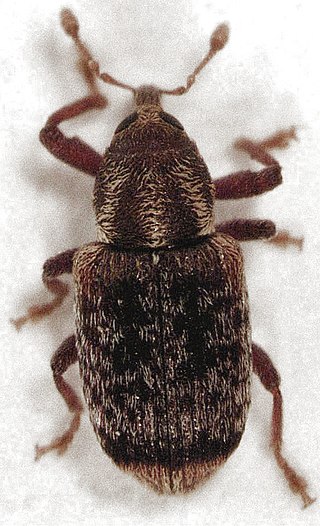
Peristoreus is a weevil genus native to New Zealand. This genus was first described in 1877 by Theodor Franz Wilhelm Kirsch.

Isoplectron is a genus of cave wētā in the family Rhaphidophoridae with three species currently recognised. The genus is endemic to New Zealand and distributed throughout the country.

Pericoptus punctatus is a sand scarab beetle that is endemic to New Zealand. It is a smaller and similar New Zealand scarab beetle species to Pericoptus truncatus.

Thomas Broun was a Scottish-born soldier, farmer, teacher and entomologist, who spent much of his career in New Zealand. He is known for his study of the beetles (Coleoptera) of New Zealand.

Holcaspis is a genus of beetles in the family Carabidae, endemic to New Zealand.
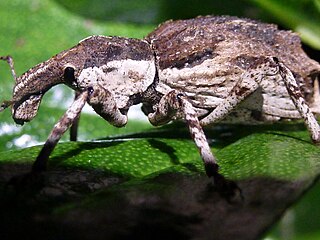
Anagotus stephenensis, commonly known as the ngaio weevil, is a large flightless weevil that is only found on Stephens Island in New Zealand. The ngaio weevil was discovered in 1916 by A.C. O'Connor on Stephens Island. Thomas Broun described it in 1921 as Phaeophanus oconnori after its collector. The weevils were observed at the time to be 'feeding on tall fescue and the leaves of trees'.

Didymocantha obliqua is a species of longhorn beetle native to Australia. It is an established exotic in New Zealand.
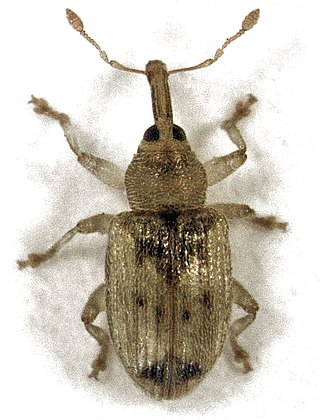
Peristoreus stramineus is a species of true weevil. It is endemic to New Zealand. The larvae develop in flower buds of Hoheria populnea.

Peristoreus fulvus is a species of true weevil. It is endemic to New Zealand. It is associated with plants of the genus Muehlenbeckia.
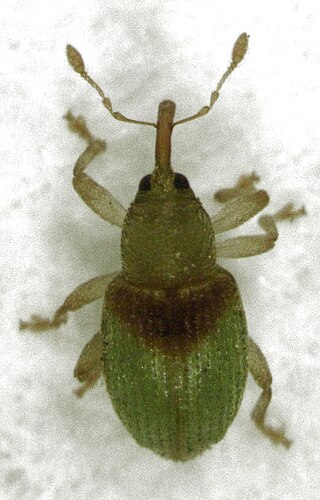
Peristoreus viridipennis is a species of true weevil. It is endemic to New Zealand. It is associated with plants of the genus Muehlenbeckia.

Blosyropus spinosus, also known as the spiny longhorn or spiny silver-pine borer, is a rare species of longhorn beetle endemic to New Zealand. It has no specific Māori name, but the term for large longhorns of this type are howaka and kapapa.
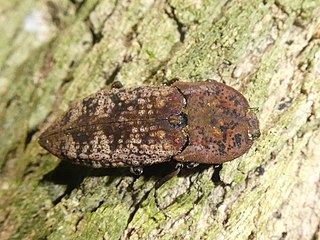
Amychus granulatus, commonly known as the Cook Strait click beetle, is a large flightless click beetle in the family Elateridae.

Hadramphus spinipennis, commonly called the coxella weevil, is a large, nocturnal, flightless weevil only found on Mangere and Rangatira Islands in the Chatham Islands, New Zealand.

Kenocoelus is a genus of rove beetles containing a number of species, all endemic to New Zealand. It is part of the Trichonychini tribe, in the Pselaphinae subfamily of Staphylinidae.

Saphobius inflatipes is one of several species of dung beetle that are endemic to New Zealand. It belongs to the tribe Deltochilini of the family Scarabaeidae. It was first described by Thomas Broun in 1893.In the Auckland region, it is most abundant during the summer and autumn seasons.

Helmoreus is a genus of fungus weevil which was circumscribed by the New Zealand entomologist Beverley Holloway in 1982. The generic name honors the scientific illustrator Des Helmore. It is found in New Zealand, Australia, and New Caledonia. It is in the tribe Stenocerini.

Eucolaspis is a genus of leaf beetles in the subfamily Eumolpinae. It is native to New Zealand, where it is a serious pest of apple trees and other fruit crops. The genus has also been reported from Fiji.
Brenda Mabel May was a New Zealand speleological entomologist known for her contributions to the understanding of weevil larvae biology. Between 1956 and 1980, she worked in the Entomology Division of the Department of Scientific and Industrial Research (DSIR). Afterwards, she became a research associate at Landcare Research, where she completed a systematic overview of New Zealand Curculionoidea, published in 1993. In 1998, May was elected as a Fellow of the Entomological Society of New Zealand in recognition of her contributions.
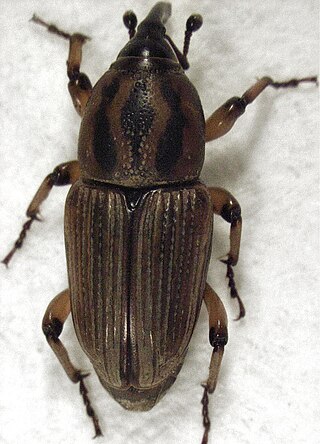
Sphenophorus brunnipennis is a beetle in the Dryophthoridae family.

Prodontria longitarsis is a species of flightless beetle in the family Scarabaeidae. This species was first described by Broun in 1909 as Odontria longitarsis. The holotype specimen was collected by George Hudson during the Sub-Antarctic Islands Scientific Expedition and is held at Te Papa.



















